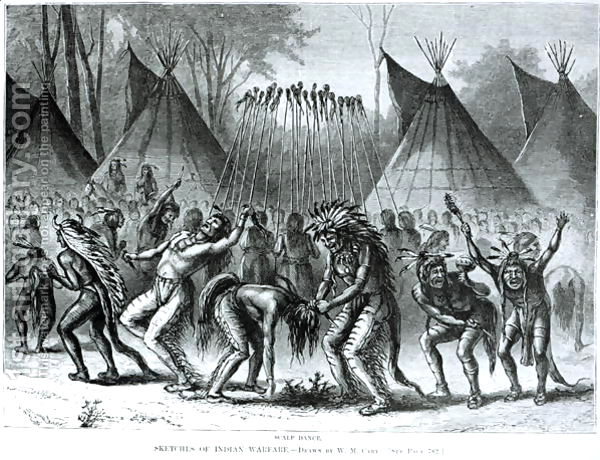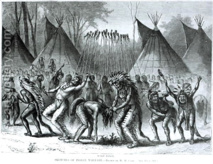The work will be conducted "in close cooperation" with members of the Sault Ste. Marie Tribe of Chippewa Indians, who say the scalp came from a mid-19th century member of the nation.
"The results of this research are going to be the basis to examine potential claims for repatriation," Claudia Kaulfuss, the museum's managing director, said in a statement.
"In respect for the collective feelings of the Chippewa Indians, we are going to conduct our joint research work on the scalp (with the) highest possible scientific accuracy," she added.
The private museum opened in 1928 and is dedicated to the works of wildly popular German adventure writer Karl May, who died in 1912, and the cultural heritage of American Indians.
His Wild West novels about fictional characters such as Winnetou and Old Shatterhand sold millions and have been translated into about 40 languages, the museum website says.
- A sensitive matter -
The museum acquired the scalp via Patty Frank, an Austrian circus artist who travelled and collected items from American Indian culture and co-founded the museum with May's widow, Clara.
But in March it received a letter and email from Cecil Pavlat, the repatriation specialist of the Sault Ste. Marie Tribe of Chippewa Indians in Michigan, calling for the scalp's release and repatriation, the museum said.
Pavlat then visited the museum, whose collections include artefacts such as moccasins and totem poles, and met members of its board and Kaulfuss, spokeswoman Anne Barnitzke told AFP.
In June, both parties signed a letter of understanding.
Barnitzke, who has recently been employed as a spokeswoman by the museum to help handle the case, said it was the first repatriation claim for a scalp in Germany that had been made public, and noted how sensitive the matter was.
Pavlat's claim is based on a caption for a photo of the scalp in a story written by Frank as part of a collection of texts published in a book in 1929, she said.
In the story, Frank writes about how he acquired his first scalp in exchange for 100 dollars and three bottles of liquor, in a style that is a mixture of reality and fantasy.
It has also not been verified who wrote the photo caption, Barnitzke said.
"Therefore it's not really clear if the story he tells is real," she said.
Barnitzke said it was likely to take years to fully research the case.
In September 2011 Germany handed back 20 skulls spirited away from Namibia a century ago at a formal handover featuring tribal leaders, government officials and descendants of Herero and Nama victims massacred by German imperial troops.
The skulls were among an estimated 300 taken to Germany after a slaughter of indigenous Namibians during an anti-colonial uprising in what was then called South West Africa, which Berlin ruled from 1884 to 1915.
And last year a leading German hospital said it had handed over the skulls and bones of 33 Aborigines to Australian representatives to be returned for burial.
----------------------------------------------------------------------------------------------
"The results of this research are going to be the basis to examine potential claims for repatriation," Claudia Kaulfuss, the museum's managing director, said in a statement.
"In respect for the collective feelings of the Chippewa Indians, we are going to conduct our joint research work on the scalp (with the) highest possible scientific accuracy," she added.
The private museum opened in 1928 and is dedicated to the works of wildly popular German adventure writer Karl May, who died in 1912, and the cultural heritage of American Indians.
His Wild West novels about fictional characters such as Winnetou and Old Shatterhand sold millions and have been translated into about 40 languages, the museum website says.
- A sensitive matter -
The museum acquired the scalp via Patty Frank, an Austrian circus artist who travelled and collected items from American Indian culture and co-founded the museum with May's widow, Clara.
But in March it received a letter and email from Cecil Pavlat, the repatriation specialist of the Sault Ste. Marie Tribe of Chippewa Indians in Michigan, calling for the scalp's release and repatriation, the museum said.
Pavlat then visited the museum, whose collections include artefacts such as moccasins and totem poles, and met members of its board and Kaulfuss, spokeswoman Anne Barnitzke told AFP.
In June, both parties signed a letter of understanding.
Barnitzke, who has recently been employed as a spokeswoman by the museum to help handle the case, said it was the first repatriation claim for a scalp in Germany that had been made public, and noted how sensitive the matter was.
Pavlat's claim is based on a caption for a photo of the scalp in a story written by Frank as part of a collection of texts published in a book in 1929, she said.
In the story, Frank writes about how he acquired his first scalp in exchange for 100 dollars and three bottles of liquor, in a style that is a mixture of reality and fantasy.
It has also not been verified who wrote the photo caption, Barnitzke said.
"Therefore it's not really clear if the story he tells is real," she said.
Barnitzke said it was likely to take years to fully research the case.
In September 2011 Germany handed back 20 skulls spirited away from Namibia a century ago at a formal handover featuring tribal leaders, government officials and descendants of Herero and Nama victims massacred by German imperial troops.
The skulls were among an estimated 300 taken to Germany after a slaughter of indigenous Namibians during an anti-colonial uprising in what was then called South West Africa, which Berlin ruled from 1884 to 1915.
And last year a leading German hospital said it had handed over the skulls and bones of 33 Aborigines to Australian representatives to be returned for burial.
----------------------------------------------------------------------------------------------









 Home
Home Politics
Politics











